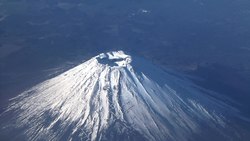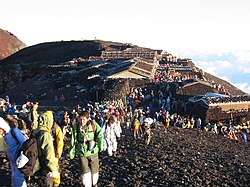Fuji Sankei Mandara from Fujisan Hongu Sengen Taisha
Autor/Urheber:
Kano Motonobu (1476-1559) 狩野元信
Shortlink:
Quelle:
Größe:
1652 x 2554 Pixel (8901349 Bytes)
Beschreibung:
Fuji Sankei Mandara (Fuji pilgrimage mandala), hanging scroll, Muromachi period (sixteenth century). Ink and colors on silk, 186.6 x 118.2 cm. From the Fujisan Hongū Sengen Taisha, Shizuoka. There has been a tradition of making religious pilgrimages to Fuji-san since ancient times. The Fuji Mandala Zu from the Muromachi period (1336-1573) shows Fuji-san towering between the sun and the moon. Below the trail leading to the top of the peak is the shrine itself, and further below runs a stream where ablutions were performed. One of the Fuji Mandala dating from the Edo period, meanwhile, features the Amida triad (Amida flanked by the bodhisattvas Kannon and Seishi) on Fuji’s three peaks. At the summit of Fuji-san is a shrine to Konohana Sakuya-hime (Tree Blossom Princess), a Shinto deity who appears in the Kojiki (Records of Ancient Matters). The mountain has thus been the object of syncretic worship in both the Shinto and Buddhist traditions and is an excellent example of the broadminded, nonexclusive nature of the Japanese people’s religious beliefs.
Lizenz:
Public domain
Credit:
Courtesy of Fujisan Hongū Sengen Taisha (in Fujinomiya, Shizuoka Prefecture)
Relevante Bilder
Relevante Artikel
Fuji (Vulkan)Der Fuji ist ein Vulkan und mit 3776,24 m Höhe über dem Meeresspiegel der höchste Berg Japans. Sein Gipfel befindet sich auf der japanischen Hauptinsel Honshū an der Grenze zwischen den Präfekturen Yamanashi und Shizuoka. Seit 2013 ist er Teil des Weltkulturerbes. .. weiterlesen













